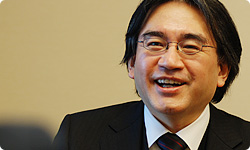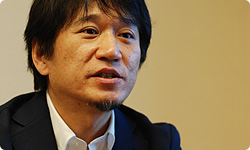2. Dialing a Wrong Number Lands a Job at NAMCO
Is that how you went knocking on NAMCO’s door?
Yes, but I actually wanted to get into KONAMI!
Huh?
I was going to apply to KONAMI, but (in Japanese, ) their names are both composed of three katakana characters, so I got confused and applied to NAMCO! (laughs)
Are you serious? (laughs)
Yes! A friend of mine was working at KONAMI. I told him I was thinking about getting into the gaming industry and he said I should give it a shot. At the time, KONAMI was headquartered in Kobe.
Not far from your home in Nishinomiya.
Right. So I put in a phone call, but got NAMCO instead!
(laughs) So if you hadn’t dialled the wrong number, you might not be sitting here today. (laughs)
Maybe not. (laughs)
Why did you go ahead and join NAMCO?
The person I spoke to in Human Resources was really helpful. When I first called, I said I wanted to work in design. He said they weren’t hiring for that position, but they had an opening in marketing.
Really? You applied to marketing? (laughs)
Yeah. (laughs)
Interesting. (laughs)
I asked what kind of work it was, and he said that if I wanted to do design work, store design was a possibility. He suggested I apply for that, and I said it might not be for me.
(laughs)
But I asked him to let me send my work, along with the application forms, and then he said, “Sure, just send it in.”
From there they were able to put you in game development. If that person had just said they weren’t hiring and hadn’t said there was an opening in marketing, you wouldn’t have sent in the forms.
That’s right.
And if you hadn’t sent in the forms, you wouldn’t have had a chance at all.
Yeah. In that sense, it was a series of chance happenings.
In general, human beings only reach the present via a string of chance connections chosen by fate. But in your case, I feel like the degree of chance was really high! (laughs)

I suppose so! (laughs) AND if I take out the part about the wrong number, there’s a perfect connection from Pac-Man to NAMCO! (laughs)
To go back even further, there’s a perfect connection with Xevious, which you played at the video arcade as a child! (laughs)
You’re right! (laughs) After that, I also played Steel Gunner6 and Final Lap.7 I hardly played anything but NAMCO games back then, and in the end that was alright. 6Steel Gunner: A gun-shooting game that appeared in arcades in 1990. Developed by NAMCO Ltd. (now NAMCO BANDAI Games Inc.). 7Final Lap: A racing game that appeared in arcades in Japan in 1987. Developed by NAMCO Ltd. (now NAMCO BANDAI Games Inc.).
(laughs) What did you work on first after becoming a designer at NAMCO?
A shooting-style arcade game called Air Combat.8 I thought NAMCO was a really interesting company, because when I first joined, they made me practice for ages using a 2D graphics tool. 8Air Combat: A flight shooting game that appeared in arcades in Japan in 1992. Developed by NAMCO Ltd. (now NAMCO BANDAI Games Inc.). It was later released for a home console under the same title.
To be prepared to design pixel art.
Right. Then all of a sudden they said, “Sakagami-kun*, we’ve got work for you!” They asked me to work on Air Combat, which was 3D, so I wasn’t ready at all! *Editor’s Note: Like "san", "kun" is an honorific that is used at the end of someone's name. "Kun" is typically used when you talk to someone who is younger than you, and "san" is commonly used as a title of respect.
Your practice in pixel art wouldn’t be of any use at all. (laughs)
That’s right. When they showed me the 3D tool all of a sudden, I said, “Well, I’ve never used this before,” and my group leader got angry and said, “Well, what have you been doing all this time?!”
(laughs)
I didn’t know what to say! (laughs) But it was really great actually making a game as I learned how to use a new tool.

It was the early days of video games, so you must have been surrounded by people who were also learning how to use those new tools.
Yes. We all taught each other. The first game I worked on involved 3D CG (computer graphics), so I knew how to make the visuals flow in a way that would feel right—like through the camerawork, for example.
You could make use of your experience working for the video production company.
Right. I thought my experience had come in really handy.
You joined NAMCO at just the right time. In the days of Pac-Man, video games had basically been composed of mere symbols, but about the time you joined NAMCO, they were in 3D CG, so movie-like visuals were needed.
That’s right. That’s really true.
So while it may look at first glance like you took an indirect route by working in video production, your time working hard and only getting three hours of sleep actually proved incredibly useful.
That’s right. At that time, no one knew filming jargon like “pan” for moving the camera horizontally or “tilt” for rotating it vertically. When it came to determining the length of superimposed text, the staff was editing it in an almost haphazard way. They would look at the display and say, “It’s too long. Shall we make it shorter?” or “It’s too short. Shall we make it longer?” They adjusted it on feeling alone.
That doesn’t work, does it?
No. It takes too much time. I told them to try confining something to be read all at once to an even number of seconds. First you set it for four or six seconds, and then you can cut it down or lengthen it a little.
Is that common knowledge for someone who has built up experience in producing videos?
No, no one tells you.
You just find it out for yourself?
Yeah. Every day, I watched the film editor, and I observed the director cutting off edits like eight frames here and there, saying, “Maybe it’s a little too long.”
It’s an artisan’s world, so you learn by watching. Once you have that kind of skill, even if you haven’t been at the company very long, chances come along quite quickly to become involved in a variety of things.
Then, before development of Air Combat was over, they said, “Hey, you’re not so bad, Sakagami,” and I joined the team making an arcade racing game called Final Lap R.9 I’d just entered the company and I was working on two games at once! 9Final Lap R: A racing game that appeared in arcades in 1993 as a sequel in the Final Lap series. Developed by NAMCO Ltd. (now NAMCO BANDAI Games Inc.).
When a place that makes things is really rolling along, that kind of thing happens.
Yeah. Even if someone was really busy, there was a strong atmosphere of “Give it a shot!” At the time, I really felt like, “If you’ll give it to me, I’ll do my best!” Now, though, I’d definitely turn it down. (laughs)
(laughs)